My Two Worst Days with the CPR True Stories From Jack Buller
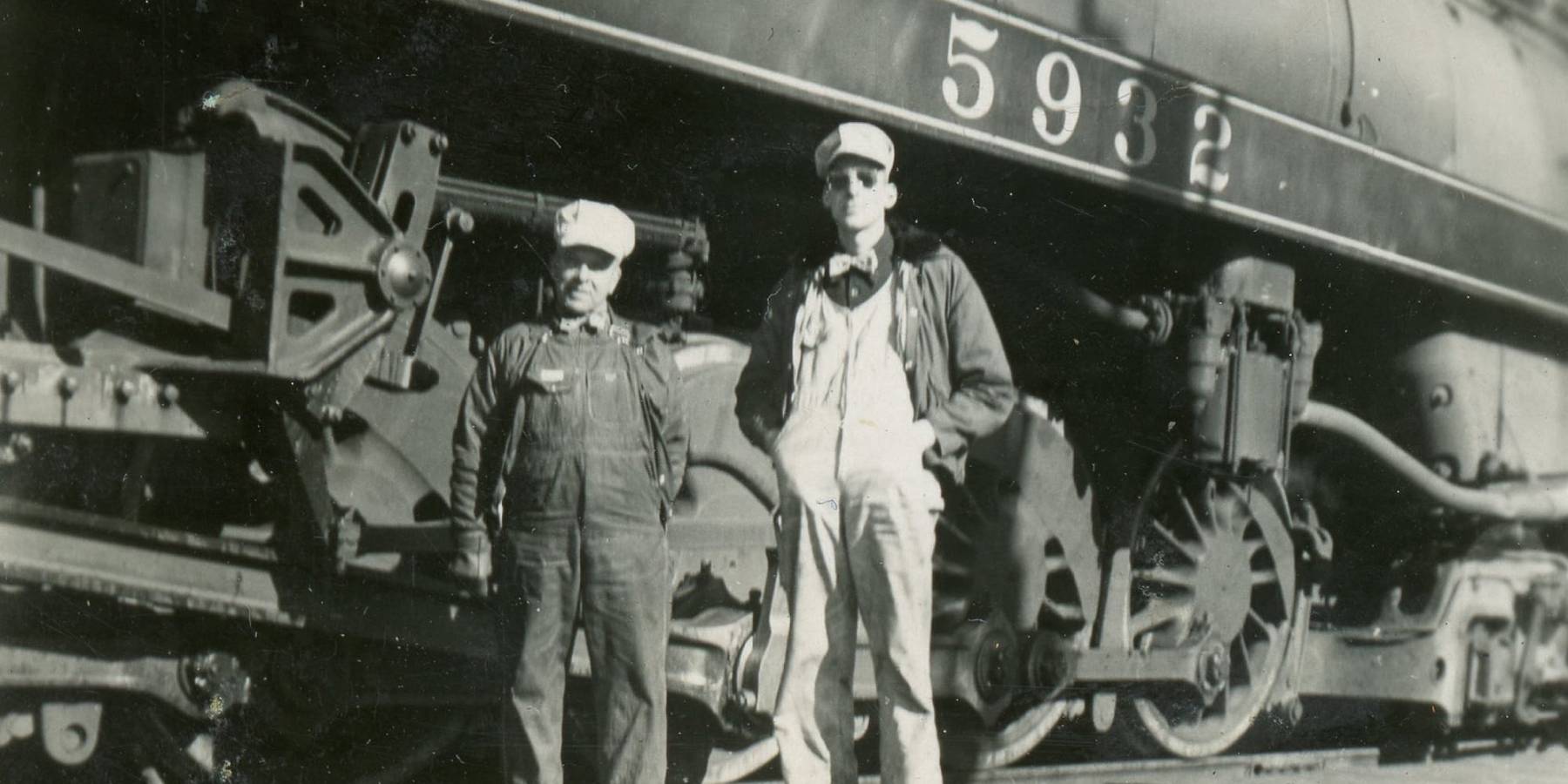

It’s rare these days to encounter a man who worked during the era of steam railroading, but the late dual Canada/US citizen Jack Buller of Florida is one of them. He began his career with CP in 1942 at Revelstoke, BC, and evolved with the railway into the diesel era.
I never met Jack in person, but we shared historical interests through the miracle of the Internet, which he used proficiently until passing away at the end of 2023. I’ll let Jack tell his first tale on his own...
Buller’s Tale From 1956
During the winter of 1956 I was railroading for Canadian Pacific in their Mountain Division between Field and Revelstoke. It was maybe -20° F with snow, and around 0200 hrs. I was running three GMD 4000 series locomotives (one A and two B) with a train of about 40 freight cars. Two men were in the cab with me, plus a conductor and tail-end brakeman in the caboose. It was cold, damn cold.
...we’d lost the end car—with the brakeman—the chain must have broken!
Our trip was routine all the way west through Kicking Horse canyon in the Rockies. In the next mountain range to cross, the Selkirks, we started up a 2% grade. We had just passed the siding at Griffith when the train went into emergency braking. The head-end brakeman got down and walked back to see what was the problem. After a bit, he returned and shouted up that we had a broken drawbar on the nearest end of a boxcar about eight cars back. We needed a chain to pull it up to the next siding because there was no other way to connect to it. That siding ahead was Sturdee, about two miles away.
My fireman, Marvin Bond, then got down to help the brakeman find a chain in the trailing unit. He came back to the cab to keep warm while the brakeman clung to the boxcar ladder. When I reached the siding I kept looking for his lantern signal to stop.
It didn’t come, so I stopped on my own, knowing I’d gone too far. Marvin checked, and then returned to say we’d lost the end car—with the brakeman—the chain must have broken!
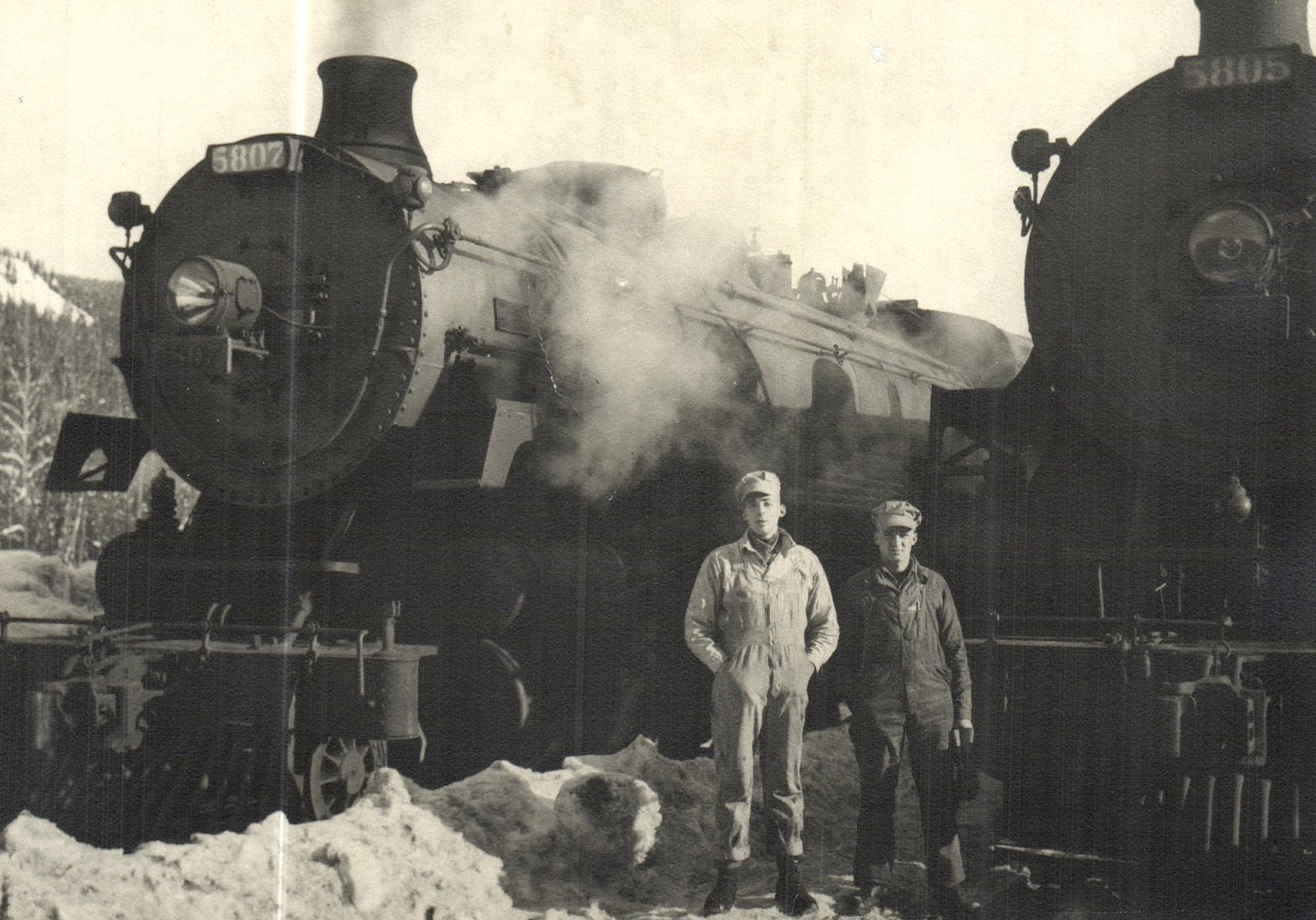
Jack Buller (left) and the late Victor “Vic” Kavolinas, both CPR firemen with pushers at Beavermouth, BC, April 1949. These 5800 engines would assist trains climbing the eastern grade of the Selkirk Mountains to Stoney Creek or to Glacier. Both men are from Revelstoke. Photo © late Ralph Humphreys.
In those days we didn’t have radios and the only communication was a phone in each siding shack connected to the dispatcher in Revelstoke. I was concerned. We might have a runaway! I got on the phone to explain the problem. He informed me our conductor had also called on the phone from Griffith, so with him involved, I said I’d get Marvin to guide me back. Marvin rode the last boxcar as we backed slowly downgrade until we found the lost car and brakeman. After the chain snapped, he had stopped it from rolling away with the handbrake. Disaster had been averted because he had properly ridden the rescued car, and not the train.
I was concerned. We might have a runaway! I got on the phone to explain the problem.
It was still snowing, terribly cold, and pitch dark. We located another chain, secured the boxcar again, and proceeded to Sturdee. With the errant car set out at that siding, we backed again to our train, coupled up, and I attempted the lift—Wham! Another drawbar broke, this one fortunately on the far end of the car, so we were able to take it too to Sturdee without anyone hanging on outside in foul weather.
Back at Sturdee, I informed the dispatcher my train was frozen and I needed a push to get moving. I couldn’t risk another coupling failure. Arrangements were made to have a following train stop at Rogers, which was at the bottom of the grade, uncouple its locomotives, and give me a push so I could proceed on my own. After tying up national rail traffic for five hours, I knew someone would be called on the carpet for all this, and that would be me.
The next day, the Master Mechanic had me in his office. He figured my unit lost traction momentarily with the starting strain, and when it jerked on regained traction, it fractured the drawbars. It is known that severe temperatures cause metals to lose elasticity and become brittle. So, thankfully, I wasn’t awarded any demerits for that bad trip.
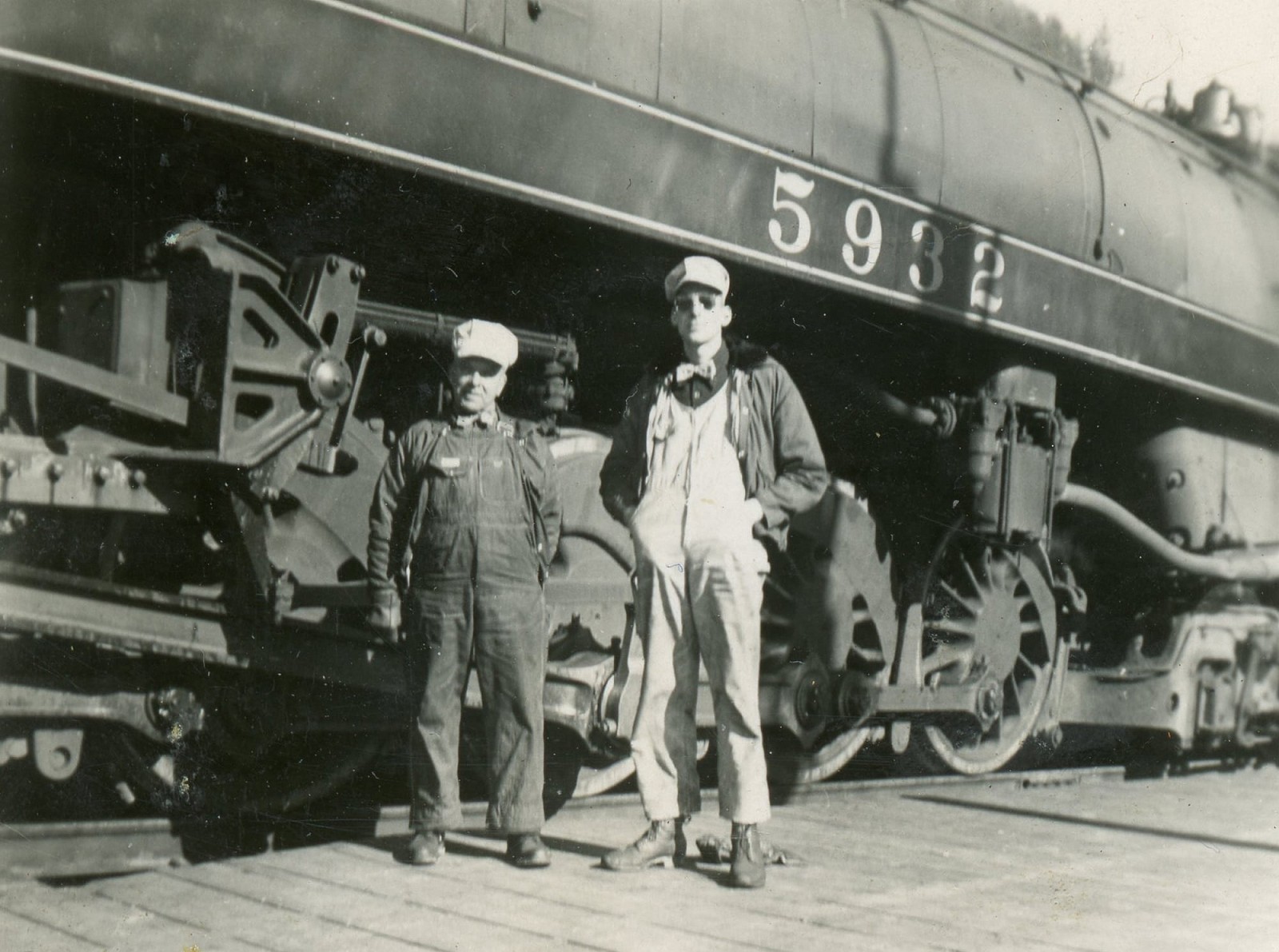
A Selkirk 2-10-4 locomotive at the Golden, BC, station about 1950. It is pulling eastbound passenger train #8. Engineer is the late Joseph “Joby” Lapworth, the tall fireman is Jack Buller; both of Revelstoke. Photo © Barbara Woods.
Jack began railroading at age 16. He was living in the farming hamlet of Albert Canyon, about 20 miles by rail east of Revelstoke. Seeing no future for himself there, he climbed into an empty boxcar and rode to town to speak with the foreman of the roundhouse at that Divisional point. There he presented his credentials—that two of his uncles were already running crew, and he wanted to do the same!
Within a week, a telegram came that he could start immediately as a wiper. It was 24 July 1942. A year later he found himself in Cranbrook, hand-bombing 3600s on the CPR’s southern route. It was there he found himself involved in a head-on collision.
Buller Survives a Head-On
I was called on the morning of August 4, 1943 to perform the duties of a fireman for engineer Sydney “Scottie” Malcolm, taking extra 3685 westbound from Crowsnest Pass to Cranbrook. The train was mainly old boxcars loaded with coal. All locomotives in that subdivision were still hand-fired, so these loads may have been in company service. Heading west, we received orders at Fernie to meet eastbound train extra 3621 at Caithness siding, which is about 30 miles east of Cranbrook.
My train was to ‘take the hole’ at the meet. The grade coming into Caithness is downhill, so we didn’t require engine power. As we approached the siding, our train was moving on a long curve and we could see our meet clearly on the mainline.
[I] didn’t stop running until I reached the caboose of the train we collided with.
My firebox required attention, so I was busy shaking the grates and upgrading my fire when Scottie suddenly yelled, “Jump, kid!”
I looked out and saw we were moving about 15 miles per hour and headed straight for a collision. The brakeman riding our pilot was also looking around, figuring which way to offload. We were going too fast for him to reach the siding switch ahead, which was aligned for the mainline. The opposing train was in the clear, but still coming to a stop short of the switch.
I scrambled down the ladder partway, then took a leap, cleared a four-foot fence, and didn’t stop running until I reached the caboose of the train we collided with. I was afraid of an explosion. Engine 3621 and several cars slid down an embankment and ended up on their sides, but nothing blew up.
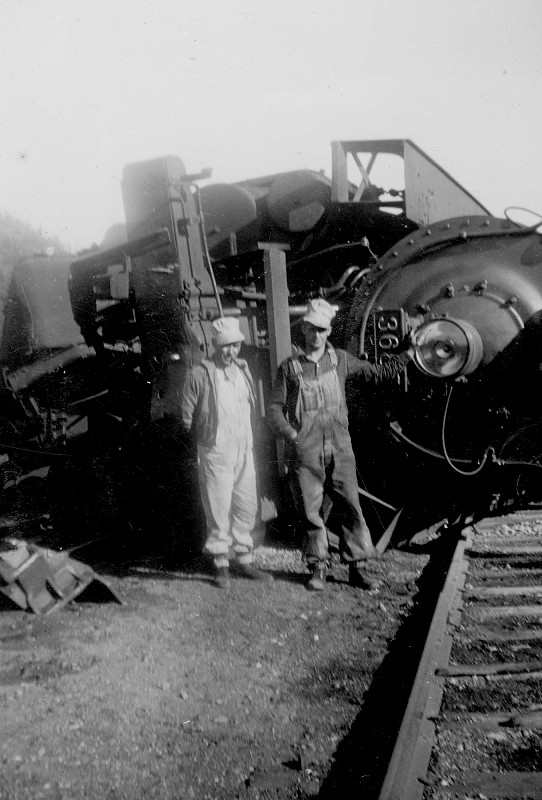
In front of CP 3685 are engineer “Andy” DeBuysscher (left) and fireman Jerry Armstrong of Cranbrook. Their engine 3685 was on the eastbound train located on the mainline. Photo courtesy of Cranbrook Archive A2002-03.
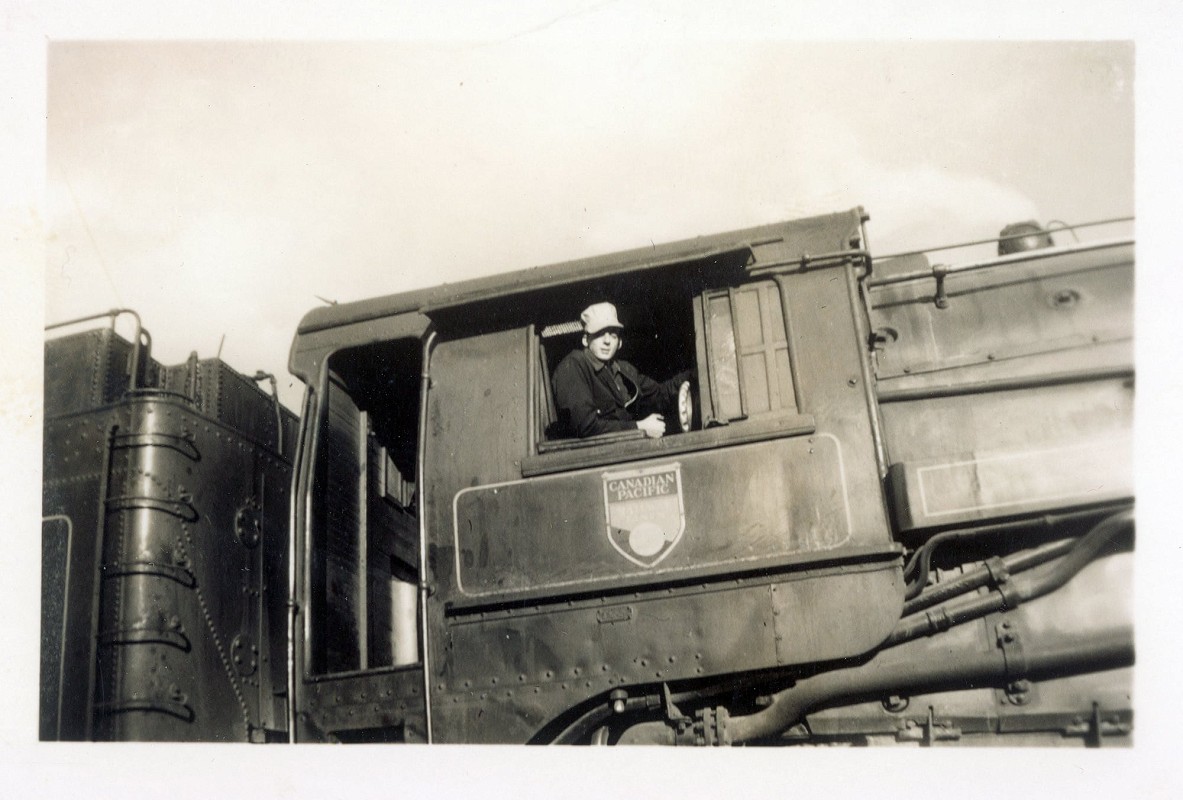
Buller in the engineer’s seat of CP 5905 at Revelstoke in 1946. He was a fireman on the spare board at this time. Photo © late Ralph Humphreys.
The cause of the accident was a misunderstanding on the part of engineer Malcom. He incorrectly assumed 3621 had stopped on the mainline, but it was actually still moving into position. Thus its brakeman had not thrown the switch in our favour, and we were moving too fast to throw it ourselves. Engineer Malcolm had released his train brakes and because of the old style airbrake system (K1 Triple), and with the inability to recharge his main air reservoir, it resulted in inadequate pressure to apply emergency braking.
The rattled man badly needed a smoke!
There were no injuries thankfully, but one concern after the crash was the whereabouts of Malcolm. He was located crawling through the wreckage of 3685, among broken pipes with steam and scalding water still escaping, looking for his pipe. The rattled man badly needed a smoke! Damage from the collision was fortunately slight, but with two locomotives temporarily out of service, four boxcars smashed, and traffic delayed for a couple of days, it was not inconsequential.
DeBuysscher and Armstrong were engineer and fireman, respectively, on the eastbound engine. They made no fault, but Malcolm made erroneous assumptions and had not communicated clearly to all his cab crew. For Jack Buller, it became mostly a youthful adventure, and didn’t deter him from continuing in the running trades at all. He qualified as engineer at Revelstoke in 1950.
Quite the career start for a 17-year old!

Did You Enjoy This Article?
Sign Up for More!
“The Parkin Lot” is an email newsletter that I publish occasionally for like-minded readers, fellow photographers and writers, amateur historians, publishers, and railfans. If you enjoyed this article, you’ll enjoy The Parkin Lot.
I’d love to have you on board – click below to sign up!
